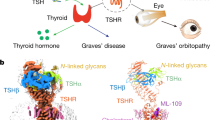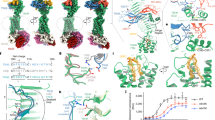Abstract
A surprising recent finding is that thyroxine binding globulin (TBG)1 and cortisol binding globulin (CBG)2, are members of the serine protease inhibitor (serpin) superfamily3. Apparently evol-ution has completely adapted the serpin structure for its new role in these proteins as a transport agent, as there is no evidence of any retained protease inhibitory activity. This drastic change in function raises the question as to why such a complex molecular framework has been selected for the relatively simple task of hormone transport? To function as inhibitors the serpins have a native stressed (S) conformation that makes them vulnerable to proteolytic cleavage, the cleavage being accompanied by an irreversible transition to a stable relaxed (R) form4,5. We demon-strate here that TBG and CBG have retained the stressed native structure typical of the inhibitor members of the family and we provide evidence that the S–R transition has been adapted to allow altered hormone delivery at inflammatory sites.
Similar content being viewed by others
References
Flink, I. L., Bailey, T. J., Gustafson, T. A., Markham, B. E. & Morkin, E. Proc. natn. Acad. Sci. U.S.A 83, 7708–7712 (1986).
Hammond, G. L. et al. Proc. natn. Acad. Sci. U.S.A. 84, 5153–5157 (1987).
Carrell, R. W. & Boswell, D. R. in Proteinase Inhibitors (eds Barrett, A. J. & Salvesen, G.) 403–420 (Elsevier, Amsterdam, 1986).
Loebermann, H., Tokuoka, R., Deisenhofer, J. & Huber, R. J. molec. Biol. 177, 531–556 (1984).
Carrell, R. W. & Owen, M. C. Nature 317, 730–732 (1985).
Carrell, R. W., Pemberton, P. A. & Boswell, D. R. Cold Spring Harb. Symp. quant. Biol. 52, 527–535 (1987).
Kress, L. F. J. cell. Biochem. 32, 51–58 (1986).
Salvesen, G. S., Catanese, J. J., Kress, L. F. & Travis, J. J. biol. Chem. 260, 2432–2436 (1985).
Scatchard, G. Ann. N.Y. Acad. Sci. 51, 660–672 (1949).
Fuchs, H. E., Michalopoulos, G. K. & Pizzo, S. V. J. cell. Biochem. 25, 231–243 (1984).
Parrillo, J. E. & Fauci, A. S. A. Rev. Pharmac. Tox. 19, 179–201 (1979).
Author information
Authors and Affiliations
Rights and permissions
About this article
Cite this article
Pemberton, P., Stein, P., Pepys, M. et al. Hormone binding globulins undergo serpin conformational change in inflammation. Nature 336, 257–258 (1988). https://doi.org/10.1038/336257a0
Received:
Accepted:
Published:
Issue Date:
DOI: https://doi.org/10.1038/336257a0
- Springer Nature Limited
This article is cited by
-
Hypothyroidism in hibernating brown bears
Thyroid Research (2023)
-
Avian corticosteroid-binding globulin: biological function and regulatory mechanisms in physiological stress responses
Frontiers in Zoology (2021)
-
Dynamics and prognostic value of the hypothalamus–pituitary–adrenal axis responses to pediatric critical illness and association with corticosteroid treatment: a prospective observational study
Intensive Care Medicine (2020)
-
Adrenal function and dysfunction in critically ill patients
Nature Reviews Endocrinology (2019)
-
Corticosteroid-binding globulin, induced in testicular Leydig cells by perfluorooctanoic acid, promotes steroid hormone synthesis
Archives of Toxicology (2018)





